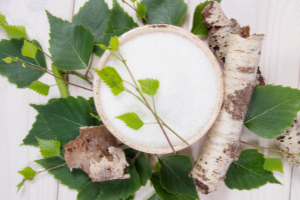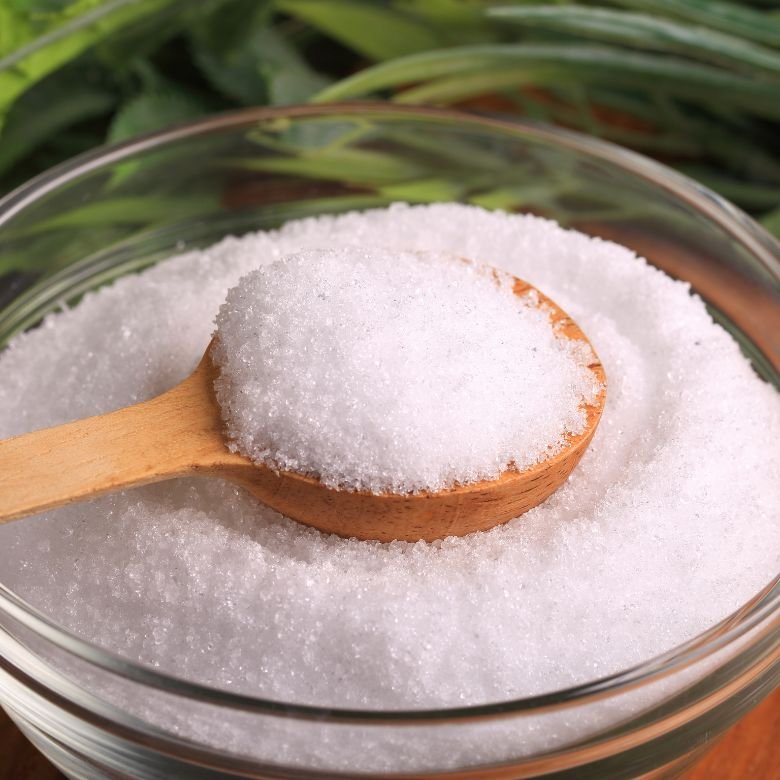Nutrition science and the chemistry of polymers are two different fields which define the term “polyols” in a completely different way, particularly in the context of different uses of these compounds.

Glycitols in food production
Polyols, which are sugar-free sweeteners, are increasingly replacing regular sugar in the food industry. In the chemical industry, other types of polyol compounds are used, among other purposes, for the production of polyurethanes.
Polyols used in the food industry are called aldithols or glycitols. They belong to the group of polyhydric alcohols, derivatives of aldoses.
In the natural environment, these compounds are found in plants and fruits such as plum, pear, peach, apple, strawberry and raspberry. Their characteristic feature is low digestibility. Therefore, their energy value (calorific value) is relatively low.
Another characteristic feature of glycitols is their low insulin and glycaemic index. Due to that, they can be used as sweeteners and an alternative to sucrose. Therefore, food producers are more likely to use glycitols as sweeteners for the production of low calorific value foods dedicated to those on a diet.
In addition, due to their strong anti-cavity effect and the ability to cause a cooling sensation, xylitol and sorbitol are perfect for the production of toothpaste, refreshing sweets and breath mints, chewing gum or mouthwash products.
Notably, glycitols such as sorbitol, xylitol, erythritol, mannitol, maltitol, isomalt, lactitol, sorbitol syrup and maltitol syrup have been approved by the European Union for use in the production of food.
Occurrence of glycitols in the environment
Glycitols, which include pentitols and hexitols, are very commonly found in nature. They are produced in particularly significant amounts by vascular plants. In areas where the bark is damaged, some species of trees and shrubs produce characteristic juices containing glycitols. Birch juice, or xylitol, can be used as an example here.
Glycitols are also found in significant amounts in seeds and grains of various plant species. The rich sources of glycitols include various types of grass, moss, cereals (bran), mushrooms and even seaweed.
Glycitols are also produced by mammals. Glycitols are found in human body fluids, namely, in blood, urine, amniotic fluid and cerebrospinal fluid.
Characteristics of selected glycitols – substitutes for regular sugar
Sugar alcohols (glycitols) are a group of compounds sharing a number of features (low calorific value, low glycaemic index and low insulin index). Despite the obvious similarity, glycitols differ from each other. Characteristics of the most popular among these compounds are presented below.
Lactitol
Lactitol is a compound obtained from lactose. It is characterised by a subtle, slightly sweet taste. It does not leave a bitter aftertaste and has a cooling effect. Compared to sucrose, the level of sweetness of lactitol ranges from 30 to 50 percent. This glycitol is used in the production of baked goods, loose bulk products, jelly, jam, chewing gums and colourful beverages.
Sorbitol
Sorbitol is a sugar alcohol naturally found in certain fruits (apples, pears, apricots, peaches, cherries). On an industrial scale, it is obtained from glucose. It is sweeter than lactitol. The level of sweetness of this compound in comparison to sucrose ranges from 50 to 70 percent. Sorbitol is used in the production of food for diabetics. It is an ingredient of beverages, candy and chocolate bars, sweets and mints. It may have a slight laxative effect. A very significant advantage of sorbitol is that it removes the bitter taste associated with other sweeteners. It is also very well soluble in water.
Xylitol
It is commonly referred to as birch sugar as it is obtained mainly from birch. In a natural form, it is also found in many vegetables and fruits. The level of sweetness of this compound is very similar to that of sucrose. Xylitol imparts a cooling and refreshing sensation to foods. On the other hand, it reduces the gelling strength of gelling agents, for example, in jam and jelly products. It is perfect for the production of chewing gums, sweets, fruit desserts, ice cream and toothpaste. Xylitol also has an anti-cavity effect.
Mannitol
Mannitol is a sugar most commonly obtained from mannose, which belongs to the group of aldohexoses. Mannose is usually not found in nature in a free state. It usually combines with other components to form glycoproteins and glycolipids, as well as polymers (mannans). Mannitol is present in small amounts in fungi. Compared to sucrose, its sweetness is about 75%. Mannitol has texture-forming and stabilising properties. It also retains moisture and may demonstrate a laxative effect. Mannitol is most commonly used as a sugar substitute in the production of foods such as jam and marmalade, jelly, chewing gum, hard biscuits, ice cream, beverages and dairy products.
Isomalt
Isomalt is a glycitol composed of two different carbohydrates – glucose and mannitol. It is produced by the enzymatic transformation of sucrose and hydrogenation. Because of its production process, isomalt can also be found under the name: “hydrogenated isomaltulose”. It is used for the production of sweets dedicated to people with diabetes. It is used in the production of jam and marmalade, fruit desserts, sugar decorations, chewing gum and dairy products. It is harmless to health, but it may cause flatulence and diarrhoea when consumed in large amounts. Isomalt used in food production has a glazing and anti-caking effect. Its sweetness, in comparison to sucrose, ranges from 40 to 60 percent.
Erythritol
Erythritol is a glycitol, and it is naturally found in certain fruits, seaweeds and lichens. It is also present in red wine. On an industrial scale, it is obtained from starch. It can be safely used by diabetics on account of its low insulin and glycaemic index. It also has an anti-cavity effect. Erythritol is a substance which has a slight cooling effect. Compared to sucrose, its sweetness level ranges from 20 to 40 percent. A distinguishing feature of erythritol is that it has the lowest calorific value among all glycitols used in the food industry. It is most commonly used in the production of products such as chocolate bars and candy bars, sweets, and chewing gum, but also medications and dietary supplements in the pharmaceutical industry.
In principle, there are no restrictions as to the consumption of glycitols in the daily diet. However, it is recommended that they should be introduced into the diet gradually and that the body’s reaction should be observed. The consumption of large amounts of glycitols may cause flatulence and diarrhoea.

Benefits of using glycitols in the daily diet
The use of glycitols in the daily diet is associated with significant benefits. Due to their calorific value, which is low when compared to regular sugar, and the low glycaemic index, they allow not only to eliminate sugar from the diet, but also guarantee the desired taste qualities of coffee or tea, if the consumer does not want to give up the sweet taste of their favourite beverages.
Notably, glycitols are much more slowly absorbed by the body compared to regular sugar. These compounds are not fully absorbed in the small intestine. When they pass to the next section of the gastrointestinal tract, they undergo fermentation. Because they are absorbed slowly, glycitols prevent sudden spikes of insulin and rapid increases in blood sugar levels.
Research on glycitols confirms that, for example, the popular xylitol is effective in the prevention of osteoporosis as it facilitates the absorption of calcium from food.
The use of glycitols in the daily diet is recommended primarily for people following a diet that significantly reduces their intake of regular sugar (diabetics, people with diabetes, and people who struggle to lose excess weight). They are also recommended to those who practise physical activity and care about their figure. Additionally, glycitols do not cause tooth decay, so they will surely appeal to those for whom having a healthy and beautiful smile is important.
Glycitols are not only in food
Apart from being used as sweeteners, sugar alcohols also have other valuable properties. They are used not only by food producers but also by producers from other industries. One example is the pharmaceutical industry, where sugar polyols are perfect as stabilisers for antibodies, vaccines and various solutions. They are also used in red blood cell products as protective agents.
Sugar polyols are a very good alternative to regular sugar. They have very similar taste qualities, but do not cause tooth decay. In addition, their calorie count is relatively lower. These characteristics mean that in food production, glycitols are often used as substitutes for regular sugar. They are considered harmful for young children; however, caution is advised when deciding how much of them to introduce into the diet.
Interesting facts
- The energy value of all glycitols has been determined to be 2.4 kcal/1g, which accounts for 60 percent of the calorific value of glucose or fructose.
- Glycitols are only partially absorbed from the digestive tract. When they reach the large intestine, they undergo fermentation as a result of the activity of the intestinal microflora.
- The absorption of glycitols is a slow process. As a result, they do not cause a sudden increase in blood glucose levels and do not stimulate insulin secretion.
- The consumption of high amounts of glycitols may cause persistent flatulence and diarrhoea.
- The recommended dose of glycitols varies from 15-50 g/day.
- https://www.researchgate.net/publication/290427845_Poliole_-_zamienniki_cukru
- http://www.farmeko.com.pl/artykul/poliole
- https://www.chemiaibiznes.com.pl/artykuly/coraz-bardziej-atrakcyjny-rynek-polioli
- https://if.mlekiemmamy.org/polsyntetyczne-wypelniacze-w-zywnosci/
- https://dietetycy.org.pl/poliole-slodycz-bez-wyrzeczen/
- https://www.guiltfree.pl/blog/2017/05/15/poliole-alkohole-cukrowe/#Erytrytol,%20erytryt